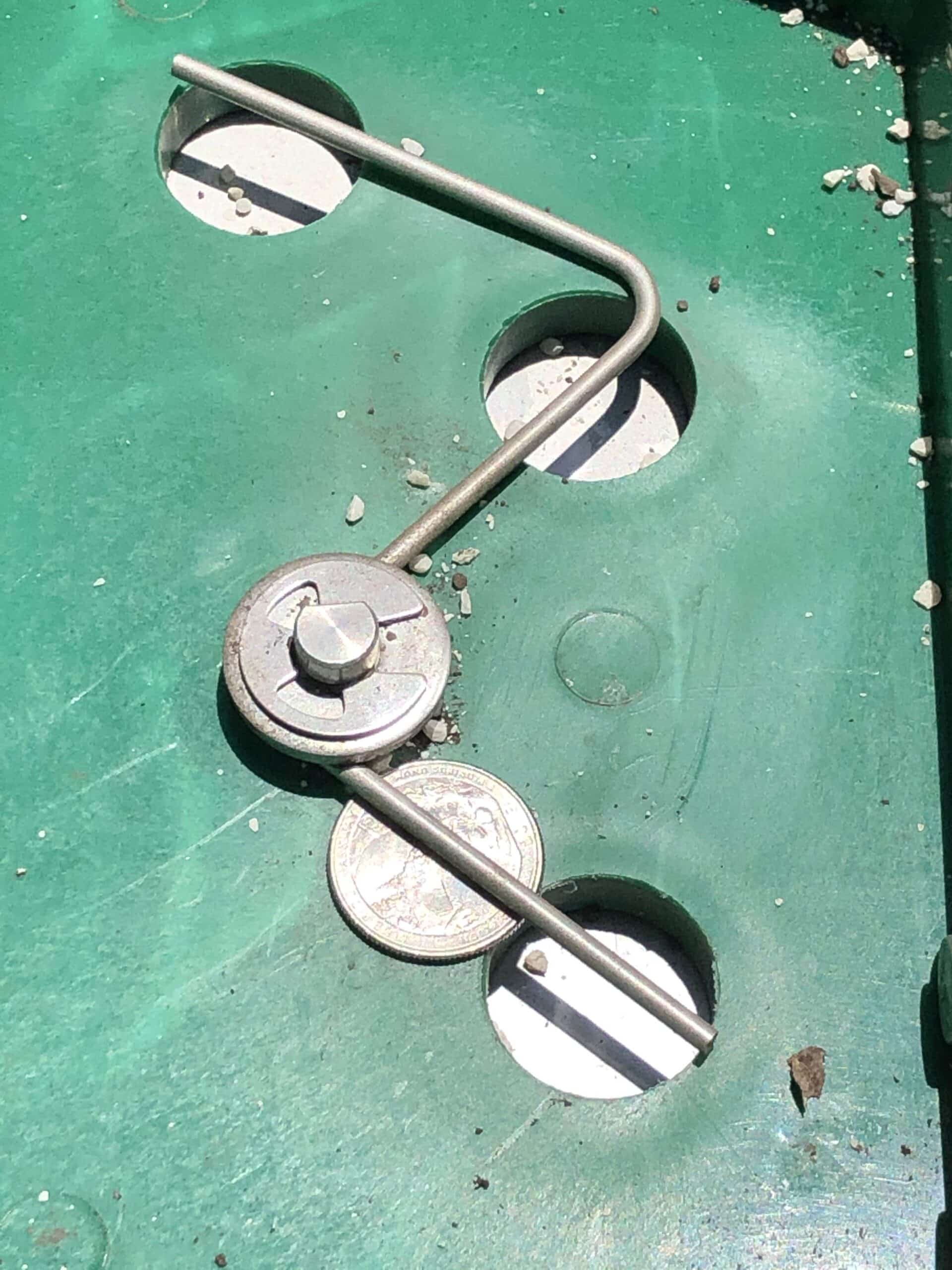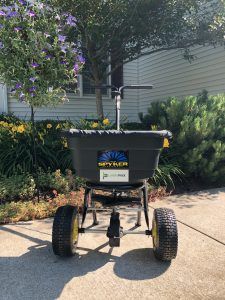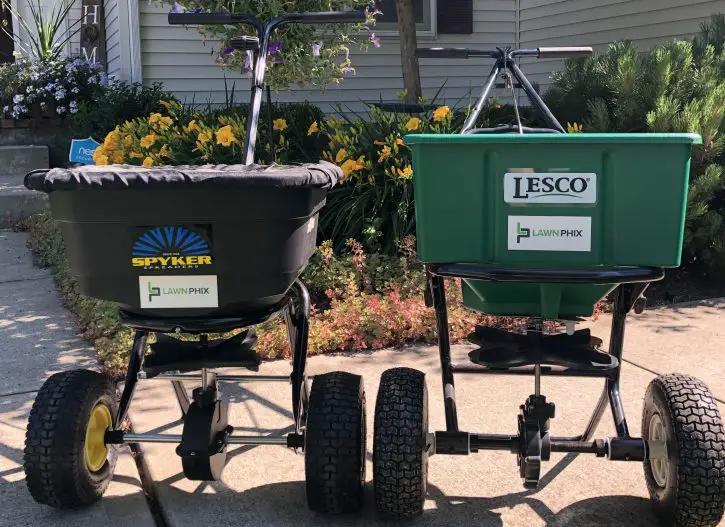There are many fertilizer spreaders types to choose from. But when it comes to prosumer models, that list gets narrowed down quickly. “Prosumer” can be defined as “an amateur who purchases equipment with quality or features suitable for professional use.” Two of the more popular broadcast fertilizer spreader brands are Lesco and Spyker spreaders.
I recently purchased the Spyker P20-5010 broadcast fertilizer spreader for my above average lawn care hobby. My buddy Pat from Mass Turf Aeration just purchased the Lesco 50 lb. broadcast spreader. Credit him for the idea, I have used both of these and have compiled some data and opinions in this spreader review.
Table of Contents
The Spreader Test
I used strictly Milorganite in both of these heavy duty fertilizer spreaders. The size of the fertilizer prills are consistently small throughout, and this organic fertilizer is widely used in both cool season and warm season grasses.
I put one 32 lbs. bag in the Spyker spreader, and one 32 lbs. bag on the Lesco spreader. I spread these evenly un/down my backyard which has a decent size slope/grade, and plenty of bumps throughout. It is also exactly 5,000 square feet so I was able to use one spreader on each half of the lawn.
The second part of the test was splitting a third bag on my front and side yard. This is very level and flat, and the total square footage is right just under 3,100 square feet.
Running the spreaders along a mix of slopes, bumps, and smooth grade absolutely made a difference.
Some things I am particularly reviewing are:
- Agitator
- Dial/settings
- Throw distance
- Throw evenness
- Spreader ‘Feel’
- Leftover Fertilizer
- Ease of cleaning
- Cost/value
Spreader Specs
| Specs | Spyker | Lesco |
| Finish | Powder-Coated Steel | Black Powder Coat |
| Material | Polyethylene Hopper | Polyethylene Hopper |
| Handle Type | 2 Position Handle Height Setting | Adjustable Handle |
| Frame Material | Powder-Coated Steel | Carbon Steel |
| Wheel Material | Pneumatic | Pneumatic Rubber Tire, Plastic Rim |
| Gear Ratio | 5:01 | 4:01 |
| Weight* | 31 lbs. | 81 lbs. |
| Wheel Size | 10 in. x 4 in. | 4.10/3.50-4 |
| Type | Broadcast | Broadcast |
| Dimensions | 38 in. x 22.5 in. x 38 in. | 48 in. x 20 in. x 35 in. |
| Capacity | 50 lb. Capacity | 50 lb. Capacity |
| Included Accessories | Hopper cover, hopper screen | Hopper screen |
*The weight of the products, full assembled, on my personal scale were:
Spyker: 24 lbs.
Lesco: 28 lbs.
Handle bars (ground level to top of handle):
- Spyker: 37.5″
- Lesco: 34″
Please view images in the gallery below for more descriptions.
Spreader Agitator
The agitator inside these two spreaders couldn’t be more different. The Spyker has your typical single metal rod agitator that spins 360 degrees. The Lesco agitator is a metal piece in a zig-zag that shifts slightly back and forth.
I was able to fit just one quarter under the Lesco agitator, and nine (9) quarters under the Spyker spreader. This is a massive difference and was expecting to see more leftover in the hopper of the Spyker when I was done spreading (more below on that).
And being so much closer to the bottom of the hopper, I am also curious to know if larger prills of fertilizer would get stuck under the Lesco agitator. Maybe a Part II review?
Verdict: tie


Spreader Dial/Settings
I opened these spreaders approximately 75% to their max. That means about 7.5 on the Spyker (out of 10) and 22.5 on the Lesco (out of 30).
The Spyker spreader has one opening and a single gate that slides open/closed. The dial clicks 1-10, and in between each number the dial clicks 10 times. So each whole number has 10 settings (i.e. 7.1, 7.2, 7.3, 7.4 etc). The Spyker user manual has a very detailed section regarding the size of the fertilizer pellets, the dial settings on the spreader, and approximately what dial setting based on number of passes (one pass for full rate; two passes for full rate).
To determine the number on the dial, Spyker has a video that says to take the weight of the fertilizer bag and multiply by 1,000. Then divide that number by the number square feet the bag of fertilizer will cover and this will give you the dial rate. In this case, Milorganite would be:
- 32 * 1,000 = 32,000 / 2,500 = 12.8
Unfortunately since this dial only goes up to 10, I suspect that video precedes this new P20-51010 model.
The Lesco spreader has three holes that also has a gate to open/close the hopper.
I like the dial on the Spyker but it’s located under the hopper and the numbers are a little hard to read. You also need to make sure the hopper is closed before making adjustments.
Loosen the screw on the Lesco and move the rate left-to-right seamlessly. You can also adjust when the hopper is open.
Verdict: Lesco
Spread Distance
I couldn’t find the spreader settings on this Lesco for Milorganite. The dial was numerical, 1-30, but what I researched online was only settings in letter form. So as previously mentioned, I opened each hooper 3/4 of the way and the Spyker definitely threw farther. In fact, Pat said that his old Earthway spreader threw farther than his Lesco, too.
Spyker: 7-feet-3-inches
Lesco: 6-feet
Verdict: Spyker
Spread Pattern
From the looks of the videos, the throw and spread pattern of these two heavy duty spreaders look pretty even. However, I did feel like the Spyker threw a little heavy to the left than the right. Upon further investigation, this is a known, or common issues. Spyker has an ‘Accuway System‘ on their newer models. This allows for the user to adjust the throw from left to right. A very cool feature that now comes standard on their newer models, but unfortunately not this particular model. The two parts to install the Accuway System are about $14, but I reviewed the P20-5010 without this feature. If this came stock, I could see this being a tie or edge going to Spyker.
Verdict: Lesco
Spreader Feel/Ergonomics
This was extremely close for many reasons. As I previously mentioned, I used these spreaders over ~8,000 total square feet on different terrain; slopes/hills and bumpy backyard, and a smooth, flat and level front yard.
First the backyard. I have to give this to Lesco. Pushing this spreader filled with 30 lbs. of fertilizer uphill just felt easier. I’m confident this has to do with the difference in gears between the Spyker P20-5010 and the Lesco 50 lb. broadcast spreader (see specs above, and videos below). Going downhill was about the same, though it did feel a little less bumpy than the Spyker
Flat terrain I give the edge to Spyker. I am about 5-foot-9 and the handles are about 3″ higher than the Lesco, and since neither of these prosumer spreaders are adjustable, I didn’t have to lift the handles as high to a comfortable position. This also allowed the spreader to remain closer to parallel to the ground – whereas the front end of the Lesco spreader was pointing closer to the ground.
Both have inflatable pneumatic tires (pics below). These are crucial when choosing a broadcast spreader, and what separates these fertilizer spreaders apart from the Scott’s of the world.
Due to the gears, you have to put a little muscle into pushing the Spyker. But once you were moving, it feels like you’re on cruise control in a Benz.
Verdict: tie
Spreader Lever
I’m a big fan of the Spyker spreader here. The on/off lever requires a much shorter distance to open/close, and much less effort to push/pull. The rod from the handle to hopper also feels like it’s sturdier.
The Lesco, when closed (forward), feels a little flimsy and rattles a bit. Check out the videos below.
Verdict: Spyker
Leftover Fertilizer
When I ran these spreaders as naturally to the end. Meaning, I didn’t bounce the spreaders around, making sure that all of the fertilizer was emptied from the hopper. I allowed the natural slopes and bumps empty the fertilizer without forcing it.
In the end, despite a massive gap between the agitator and hopper, there was less fertilizer in the Spyker than the Lesco.
- Spyker: 5.61 oz.
- Lesco: 6.67
The is most likely due to the Spyker staying much more parallel which pushing and spreading – while the nose of the Lesco tilted to the ground which caused the fertilizer to naturally slide to the front of the hopper.
Verdict: Spyker
Spreader Cleaning
I used a simple hose to rinse each fertilizer spreader and my RedMax backpack leaf blower to air dry each machine.
Cleaning the Spyker was a little easier, too, due to the screen and the design of the hopper. The Lesco has a more squared hopper, while the hopper on the Spyker is a bit more angled. This made it easier to dry the inside.
Also, as I’ll explain more below, the screen on the Spyker is removable, where the Lesco is screwed into the hopper with four phillips-head screws.
One caveat: there appeared to be water coming out of the Spyker’s enclosed gear box when I tipped it back on its handles. Spyker has a lifetime warranty so I’m not too concerned, however I’d be remiss if I didn’t mention that here.
I use a 3-in-1 oil for the Spyker after each cleaning, as that’s what’s recommended by the manufacturer. The Lesco requires greasing of the points periodically.
Verdict: Spyker
 Final Spreader Verdict: Spyker
Final Spreader Verdict: Spyker
This was a fun comparison. I’d like to do this a second time with a large, more inconsistent fertilizer prill size. Both of these two fertilizer spreaders have a large capacity hopper and will most certainly make your lawn care tasks much more enjoyable – whether you have a small lawn or a large lawn.
So, Spyker or Lesco spreader? In the end, I do enjoy the Spyker P20-5010 Spreader. I love the look and design of the spreader. I think Spyker put better R&D into their product than Lesco for sure.
Spyker comes with a cover, where Lesco does not. A neat add-on. I used it during my review and purposely walked into my sprinklers just to test it out (for fun, and to cool off).
Spyker has a grate that sits on top of the hopper and can be pulled in or out at anytime. The Lesco is anchored into the hopper with 4 small screws. A few turns of the phillips-head and the connectors loosen enough to remove. But this is just an extra step. The screws can get caked with fertilizer if not cleaned enough. And putting the grate back into place requires cleaning. Any fertilizer wedged in between will just take more time to put back into place.
Spyker has top notch customer service, too. They’re easily reached via social media – and are very active and responsive via social media, too. I communicated with them via Instagram almost instantly.
Overall I’d give the Spyker P20-5010 Spreader 4 out of 5 stars. This is a must-have for any lawn care enthusiast to add to their arsenal of lawn products. It’s a smooth ride, lightweight but a heavy duty broadcast spreader. You can find the Spyker P20-5010 Spreader on Amazon, as well as Spyker’s official website and other independent retailers.
I would not hesitate to buy the Lesco 50 lb. broadcast spreader as a second choice runner up, though. It, too, is a nice heavy duty fertilizer spreader. The Lesco 50 lb. broadcast spreader is also available on Amazon as well as your local SiteOne location.
Image Gallery
[ngg src=”galleries” ids=”25″ display=”basic_thumbnail” thumbnail_crop=”0″]


Thank you very much for such comprehensive and useful comparison of these two spreaders !
I really liked your comparison on the spreaders including seeing the videos really helped.
Thanks for the videos. The info was nice as I am considering one of these brands along with Anderson. I also have rough sloped terrain living in the mountains of Western, NC. Some questions I have and is important to my decision is durability and longevity. The Lesco appears to have the upper-hand on this having a welded support system and greased fittings for the wheel bearings. What are the gears made out of, plastic, aluminum, steel, etc. and is there a grease fitting for it? What is the width of the wheelbase exterior side of tire to exterior side and inside to inside. How stable are these on a slope, the width will provide stability, but also the height the hopper is off the ground will make a difference. Is the handle twisting moving if you have to prevent it from tipping over because of a large bump or steep slope. That will add pressure to linkage points(bolts, welds, etc). The more rigid the less stress, I would think the Lesco may handle that better being welded, but not the only determining factor as noted. Not as important is the Lesco was much more quiet almost whisper quiet in your video. That appears to indicate a superior higher quality gearing system.
Hi Steve. Thanks for the comment. The dimensions are listed near the top of the post. I’m not sure if the sound dictates the quality of the gears, but rather the ratios? You raised some good points that I’ll be sure to consider the next time I write a review. If you’re looking for specifics that the companies can’t answer I’ll do my best.
Lesco says that after your previous pass, the wheel marks of your next pass should be 10ft away. Is that accurate? If not, in order to get uniform coverage, how far away should wheel marks be from the previous passes wheel marks?
That depends on a number of different factors. Generally speaking, the fertilizer should hit the wheel marks of the previous pass. Since most of the fertilizer from a broadcast spreader is thrown in the front, this light overlap on the next pass helps create an even spread.
Here’s a great resource: https://extension.psu.edu/calibrating-your-fertilizer-spreader